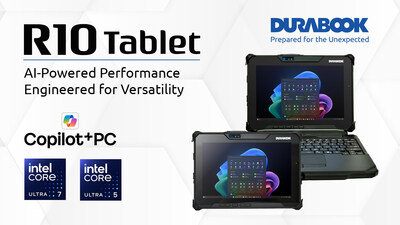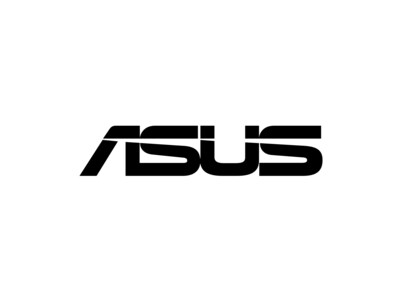The 10-inch R10 is powered by the latest Intel® Core™ Ultra 200V series processor, positioning it as one of the market’s first Copilot+ PC rugged tablets.
TAIPEI, Oct. 29, 2025 /PRNewswire/ — Durabook, the global rugged mobile solutions brand owned by Twinhead International Corporation, today announced the launch of its next-generation AI-powered fully rugged R10 tablet. Equipped with high-performance Intel® Core™ Ultra 200V series processors, the 10″ device is one of the first Copilot+ PC rugged tablets on the market. Redefining versatility in the tablet world, the R10 can be paired with a detachable backlit keyboard, seamlessly transforming it into a 2-in-1 rugged laptop PC. This adaptable design delivers the ideal balance of performance, reliability, and mobility, empowering users with a powerful and intelligent rugged device that fuses cutting-edge AI capabilities with Durabook’s hallmark durability and field-proven design.

Durabook Introduces Next-Generation R10 Copilot+ PC Rugged Tablet
Twinhead’s CEO, Fred Kao, said: “Durabook devices are built to meet the needs of professionals who depend on powerful, reliable technology to stay productive in any environment. The compact and versatile R10 redefines the 10-inch rugged tablet category by providing AI-enhanced productivity supported by smart engineering for optimal usability. The R10’s adaptive design and customisation capability make it the perfect partner for field service operatives working across a wide range of sectors, including industrial manufacturing, warehouse management, automotive diagnostics, public safety, utilities, transport and logistics.”
AI-Enhanced Performance
Equipped with the Intel® Core™ Ultra 200V series CPU, the R10 delivers exceptional computing power with enhanced AI performance, energy efficiency, and multitasking capability. Featuring new Performance/Low Power Efficient core architecture, low-latency LPDDR5X on-package memory, and speeds of up to 5.0 GHz, the R10 exceeds expectations by delivering 50% higher performance than 12th Generation Intel CPUs.
Built for AI at the edge, the R10’s combination of CPU, GPU, and NPU compute engines delivers 120 TOPS of total AI performance for real-time mission-critical decision-making. As a Copilot+ PC, the R10 also integrates on-device AI acceleration, enabling Microsoft Copilot features to run securely and smoothly, even without cloud access. This sophisticated level of tech provides 24/7 instant summarisation, intelligent search, and adaptive task management for professionals in the field.
Rugged Reliability in All Conditions
Designed to operate in the harshest conditions, the R10 meets MIL-STD-810H, 6-foot drop and IP66 standards. With proven resistance to drops, shocks, vibration, dust and even salt fog, the R10 also remains operative in the most extreme temperatures, from sub-freezing -29°C (-20°F) to 63°C (145°F) heat. Additionally, the tablet is also certified with MIL-STD 461G, for electromagnetic compatibility, and ANSI/UL C1D2 for use in specified hazardous locations and potentially explosive environments.
The R10 also features a 10.1″ TFT LCD WUXGA (1920 x 1200) DynaVue® sunlight-readable display with brightness up to 1,000 nits, so every detail of imagery is delivered with the utmost clarity in all weathers. With Microsoft Pen Protocol (MPP) 1.51 support, the R10 delivers precise stylus performance, empowering engineers to sign reports, sketch diagrams, and annotate blueprints directly on the screen with accuracy and ease.
Engineered for Connectivity and Endurance
The R10 comes equipped with a comprehensive suite of integrated technologies, including one Thunderbolt 4, USB 3.2 Gen 2 Type-A port, dual SIM (Nano SIM & eSIM), up to two RJ-45 ports and an optional serial port RS-232. In addition, wireless connectivity includes 5G/4G LTE, Wi-Fi 7, Bluetooth V5.4 and GPS, ensuring constant, secure connectivity in any environment. Adding to its versatility, the tablet supports modular expansion options tailored for field applications, such as a barcode scanner, magnetic stripe reader, smart card reader, and RFID (NFC) reader, enhancing productivity across diverse industrial and operational scenarios.
Specialised field applications require extended battery life, so the R10 features a hot-swappable battery design with an optional high-capacity battery up to 16 hours, enabling users to hot-swap batteries in the field without any downtime.
Optimal Security as Standard
Purpose-built for professionals handling sensitive data, the R10’s integrated Microsoft Pluton Security Processor provides chip-to-cloud protection at the hardware level, safeguarding credentials and encryption keys from the moment the device powers on. Advanced security support also includes TPM 2.0 as standard and optional Intel® vPro™, as well as a 5.0 MP IR camera for Windows Hello with dynamic shutter design, 11 MP rear camera with dynamic shutter design, Windows 11 Secured-core PC and an optional fingerprint scanner meet the needs of customers today in an ever-evolving mobile work environment.
Designed to deliver full computing capability in a truly mobile form, Durabook has developed the R10 with optimised usability in mind. Designed to minimise e-waste and reduce the total cost of ownership, the R10 promises long-term performance and a strong return on investment for customers working across various industries.
Availability
The new R10 fully rugged tablet is available for order now.
For more information, please visit: https://www.durabook.com/en/products/r10-tablet
Follow the DURABOOK brand
The Durabook product family of rugged laptops and tablets can be followed on various social media channels including LinkedIn, Facebook, X and YouTube.
About DURABOOK
Durabook is the core brand of Twinhead International Corporation in Taiwan, a world-renowned manufacturer of rugged mobile solutions for 40 years. All Durabook devices are designed, manufactured and tested to the highest standards to ensure maximum quality and reliability. Committed to engineering and service excellence, Durabook products have been widely adopted by government and enterprise customers including oil and gas, utilities, field service, military, and public safety for more than two decades.












